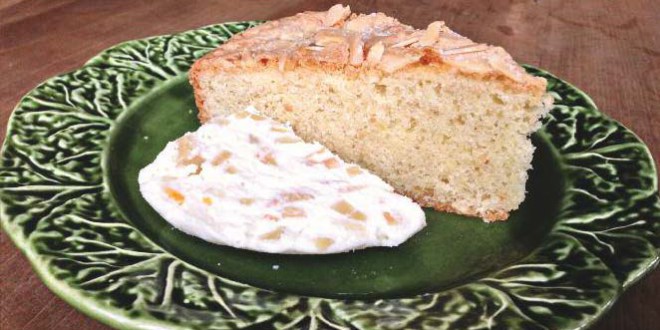by Ona Daugirdas.
Every family has its own food rituals for Holy Days and holidays. In my family, cast-in-stone Easter breakfast requirements were margučiai decorated by the children, my mother’s delectable cold roast duck, her light as a feather babka, and my dessert contribution—paska. When I married into the Daugirdas clan, I found that their Easter breakfast had lazed into brunch and duck had morphed into turkey. They insisted that it wouldn’t be Easter without vinegretas (beet potato salad) or my mother-in-law’s mozūrėlis almond cake. It was different, but it was all good. Your own Easter table is probably full of other traditional good food. Here are two recipes to add to your repertoire: paska—from the Kliorys family, and an Easter almond cake à la Halina Daugirdienė.
Paska–A Delectable Dessert
The word paska or Pascha is a transliteration of the Greek word Πάσχα, which is itself a transliteration of the Hebrew pesach, both words meaning Passover. In Orthodox Christian faiths, Pascha is the name for Easter. And it is a most fitting name for a sweet, cheese-like dessert, full of almonds and candied fruit that is served at Eastertime in Lithuania and other eastern European countries.
My mother had wonderful memories of paska from childhood Easters in Lithuania. For years she hunted for a good recipe. Most of the recipes were unacceptable because they used eggs. Sometimes these eggs were left raw in the finished product. Other times, in order to cook the eggs, the cheese needed to be steamed, almost like an English plum pudding–not an optimal treatment of dairy ingredients. And then in 1966 she found the perfect recipe in our Cleveland diocesan newspaper, The Universe Bulletin.
I was fourteen when mom designated me the official paska-maker in our family. And when mom gives you a job, you take it. My age is totally irrelevant to this story except for two reasons: if you are feeling ambivalent about paska because you’ve never tasted it or never heard of it, consider this—paska is so good, that from that 1966 Easter onward, it’s been made every year for 50(!) years in our family (do not attempt to calculate my age from this data). Once you taste it, you can’t have Easter without it. And the second reason is this: it’s not rocket science, if a freshman in high school could master the recipe, you can do it. It’s not hard, try it!
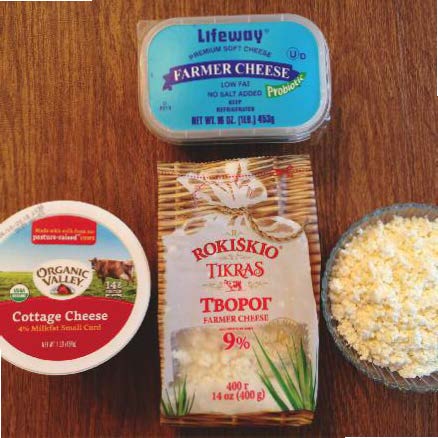
Easter Paska
Use full fat products only
14-16 oz. dry cottage cheese*
12 oz. cream cheese
8 oz. unsalted butter
1 cup sugar
1 cup sour cream
1 cup slivered blanched almonds,
toasted 1 cup finely chopped candied citron,
lemon and orange peel
*Finding old–fashioned dry cottage cheese has become nearly impossible. In recent years, out of desperation I had to buy creamed cottage cheese and rinse the cream off in a sieve. This worked, but I was not happy with the unnecessary added salt, thickeners, starch, etc. Ricotta is not what you want either. Then the stars converged: I found wonderful, natural substitutes in our local ethnic grocery stores. Also advertised as Farmer’s cheese, this is real cottage cheese (varškė)— and it’s perfect. And I also learned to make my own. Remember the Lithuanian Heritage article about making farmer’s cheese? The unseasoned curds from this recipe are ideal for paska. So you have options: good, very good, and best. If you choose the first option, buy the lowest salt, highest quality organic cottage cheese you can find and rinse off the cream. Be aware that by doing this, a 16 oz. container will lose about 4 oz. of weight, so adjust product amounts accordingly.
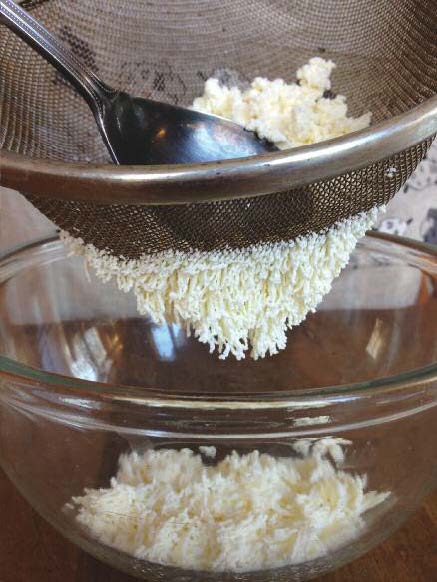
Making the cheese mixture
1. Make the paska 3 days before serving. It will need 2 days to press and drain. Mix by hand.
2. Bring all dairy ingredients to room temperature. Everything needs to be very soft in order to mix together smoothly.
3. Place half of the cottage cheese in a sieve. Using the edge of a metal spoon, scrape the cottage cheese though the sieve. Be patient, use a bit of muscle. This is the hardest part (but not very). Repeat with remaining cottage cheese. Hint: stay in one area of the sieve so that there’s less work clearing the mesh out at the end.
4. In a separate large bowl, cream the butter and cream cheese together. Make sure it’s very smooth. Add the sieved cottage cheese, sour cream and sugar, mixing well after each ingredient.
5. Lightly toast the almonds until nicely dry, but not brown. Toasting is important, to give a good crunch in the cheese–like end product. After cooling, add almonds to the mixture.
6. And lastly, finely chop the candied fruit and add it in. Make sure to use only light colored fruit peel and the best quality you can find. The role of the candied peel is to add subtle depth and hints of flavor, but the pieces need to be small since almonds are king in this recipe. If you do this right, even folks who claim to hate candied fruit will be loving it (I have testimonials!).
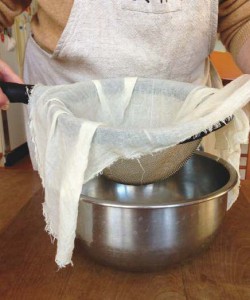
Pressing and draining
1. Find a sieve big enough to accommodate the cheese mixture. Choose a nice mounded form, since the shape of your sieve will determine the final shape of your paska. Set it in a bigger pot or bowl. Make sure the sieve does not touch the bottom, since liquid will be collecting there. Wring out a square piece of strong cheesecloth with water and lay it in the sieve..
2. Add the entire cheese mixture into the cheesecloth-lined sieve.
3. Snugly tie the opposing corners of the cheesecloth together. Don’t worry about the knots making a depression in the center. It’s fine. Alternatively, you can gather the four corners and tie in the center with twine. Make a very tight bundle.
4. Place a flat plate on top of the bundle and then add as much weight (bottles, cans) as you can manage to balance. Make sure the circumference of the plate is smaller than that of the sieve, since it needs space to sink down a bit as liquid is expelled.
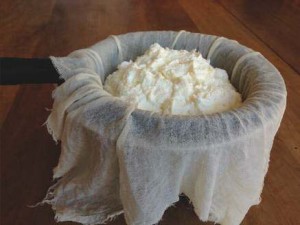
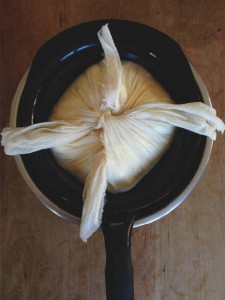
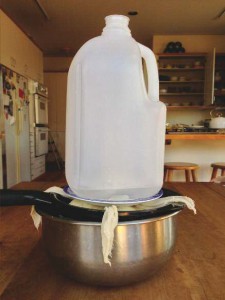
5. Keep the weighted paska in the refrigerator–you may have to remove a shelf. Check once a day for fluid accumulation in the bottom pot (the total amt. will be about 3–4 oz.). Pour it off, so that the paska is not sitting in liquid.
6. On Day 3, carefully untie the cheesecloth, unmold the paska and place it on a serving plate.
7. For Easter, decorate with chi (X) and rho (P), the first two letters of the Greek word Christos. I use dried currants to spell it out. For other occasions, use your imagination! Paska is soft, so slice in generous pieces. Enjoy by itself or with babka (sweet raisin bread) and coffee!
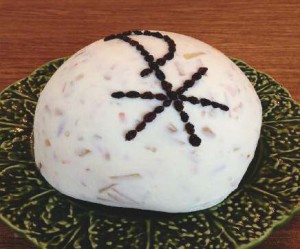
Easter Almond Cake
Almond cakes are also traditional Lithuanian desserts at Easter. My mother-in-law made a flat, sheetcake type of cake with chopped almonds inside and sliced almonds outside. It was an annual must-have, it was delicious, and it was made without a recipe. She called it mozūrėlis. After scouring a half dozen Lithuanian recipe books, I found a substitute that is actually better than the cake I remember.
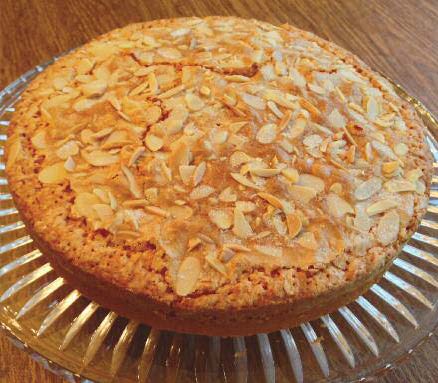
Many almond cakes call for almond paste or marzipan in their recipes. While the results are probably delicious, these cakes are often very dense and heavy. Lighter almond cakes frequently sacrifice flavor for fluffiness. This recipe combines the best of both worlds, resulting in a cake that has a very rich almond taste and a consistency that’s not too airy. Don’t be tempted to substitute almond meal or flour for the ground nuts–meal just doesn’t have much flavor. And don’t skip the toasting– it is essential for bringing out the aroma and taste of almonds. Note the small amount of baking soda. Because the cake is baked in a 300 degree oven, alkali is added just to help the cake brown.
Mozūrėlis Almond Cake
1 1/2 cup blanched sliced almonds,
toasted 3/4 cup all-purpose flour
3/4 tsp. salt
1/4 tsp. baking powder
1/8 tsp. baking soda
4 large eggs
1 1/4 cup sugar
1 Tbsp. lemon zest
3/4 tsp. almond extract
5 Tbsp. butter,
melted 1/3 cup vegetable oil
Topping:
1/2 cup sliced almonds
2 Tbsp. sugar
1–2 tsp. lemon zest
1. Heat oven to 300 degrees. Line a 9-inch round cake pan with greased and floured parchment paper. Toast, then finely chop 1½ cups almonds to a sandy texture. Combine with flour, salt, baking powder, and baking soda. Set aside.
2. Beat eggs, sugar, lemon zest, and almond extract until frothy. With mixer running, add melted butter and oil in a steady stream, until incorporated. Add the flour–almond mixture and combine. Transfer batter to prepared pan.
3. Sprinkle top of cake with 1/2 cup almonds, followed by the sugar– lemon zest mixture.
4. Bake 55 to 65 minutes. The center of cake should be set and bounce back when gently pressed, a toothpick inserted in center should come out clean. Let cake cool and settle in pan for 15 minutes. Then remove from pan and let cake cool completely, about 2 hours. Cut into wedges and serve.
Happy Easter! Linksmų Velykų !
Happy spring! Su pavasariu !
Find directions for making your own farmer’s cheese curds in the 2015 July/Aug edition of LH or send an email to: odaugirdas@hotmail.com for a pdf copy of the article.
 DRAUGAS NEWS Lithuanian World Wide News in English
DRAUGAS NEWS Lithuanian World Wide News in English
